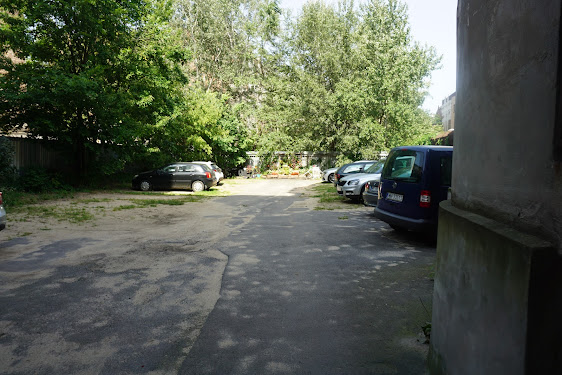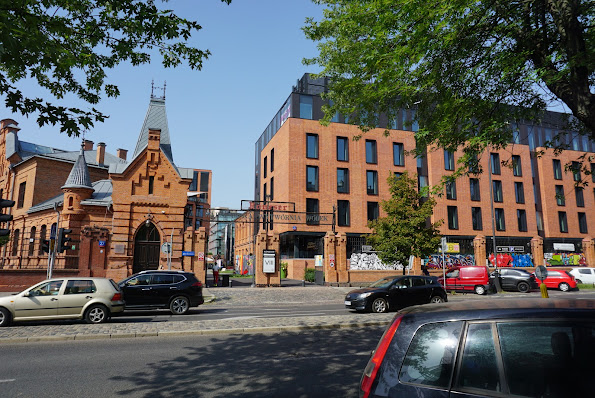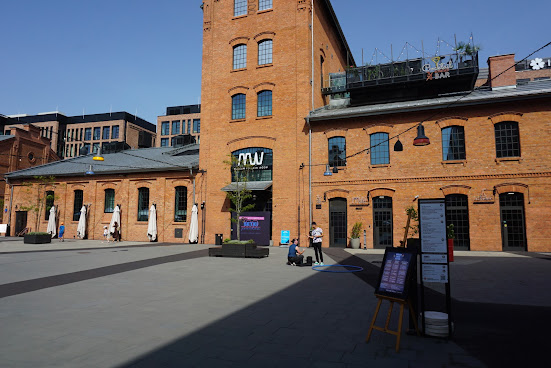Metro Wileński
Praga district in Warsaw
#Warsaw tour guide #Warsaw city guide # guided tour in warsaw #Warszawa tour guide #Warszawa city guide #guided tour in Warszawa
After they made the Metro, the Praga district has sprung out as a new district
Metro Wilenski or Metro Dworzec Wieleński is located at the Praga side of Warsaw. This has traditionally been the less ‘posh’ part of the city. It was a gathering place for those who couldn’t quite keep up with the pace and eloquent language in the city centre, and because the Russians were here during the Warsaw Uprising in 1944, the district was not destroyed by the avenging German troops.
Prewar buildings have been restored to previous beauty
The old residential buildings have made the area something special. It also relates to the communist philosophy that they would not allocate resources to renovate and modernise old buildings. Socialism wanted something completely new, and at some point they would demolish the old and build new luxury properties for the working masses. It just didn’t really happen.

This is what the whole area looked like a few years ago – but rents were cheap. They probably still are in this yet-to-be-renovated building.
The properties therefore fell into the most desolate slums, often owned by the municipality. Even after the system change in 1989, no one really had the energy to do anything about it, and residents were happy with low rents.
It used to be a slum with lots of hookers and burglars
As recently as 2015, I had a group in the area when I was tasked with showcasing Warsaw’s slums. And I guarantee that my group was suitably shocked to see that people were living in the buildings.
Houses have been refurbished and new creative people have moved in
Today, a few of the old dilapidated properties remain, but the renovation has been done at marathon speed. Most houses have been thermally insulated and returned to their former beauty. Modern sanitary facilities and district heating have also been installed.
It’s all because of the metro
What has happened, apart from the general increase in wealth, is that metro line 2 opened in 2015, embracing Praga, which had been somewhat isolated from the city centre. Suddenly, there was a mental shift and all the artist types and hipsters wanted to live in Praga. Today, it has become a vibrant neighbourhood with plenty of pubs and clubs, but the great thing is that so far only the locals have discovered it. It gives a completely different vibe to what you see on the other side of the river.

The Orthodox Cathedral
The Orthodox Cathedral (Sobór metropolitalny Świętej Równej Apostołom Marii Magdaleny). Address: Aleja Solidarności 52 – a stone’s throw from Metro Dworzec Wileński.
Built under Russian rule, after Poland’s independence in 1918 it became a cathedral, after most Orthodox churches were taken over by Catholics when Poland gained independence and the Russians left the country. With increasing immigration from countries such as Ukraine, the need for Orthodox churches is now on the rise.

A look through the main gate. You’re dazzled by the gold, but for some reason there’s a photo ban inside, so I’m sneaking this shot
The church is built in the shape of a Greek cross with a main dome and four smaller domes. The church provides a good opportunity to compare the style of the two denominations, and if you’re looking for splendour, this Orthodox cathedral is certainly not inferior to the finest Catholic churches
Jagiellońska Street and Kameralna Street with surrounding residential area

Homes with air and exciting shapes close to the metro station
Now, standing at the church and looking through the main entrance, you can turn left towards some of the new construction that can also be found on Praga. Here you’ll find a residential area from the 1960s, originally built as flats for military personnel. Built in three stages from 1948 to 1964, the area shows the human architectural face of communism. These are homes built with the well-being of the residents in mind, far from the mass-produced concrete blocks that emerged in the 1970s. Emphasis has been placed on the shape of the buildings, but there is also air between them, although this is slightly spoilt by the many parked cars, which were not part of the planning when the area was built. Particularly noteworthy is the lush vegetation that surrounds the buildings, which is predominantly maintained and expanded by the residents.

Shopping Mecca – Galeria Wilenska
The Dworzec Wileński shopping centre is just up from the Metro. The shopping centre contains much the same range of shops as other shopping centres, but has a special charm because it is housed in an old railway station and still has a local train station in the centre. If you’re going to a shopping centre, you might as well do it with atmosphere, and that’s what you’ll find here.
Walking the area around Metro Wilenski
You can access two different sides of Targowa Street. One side is where the shopping centre is located, while there is a large post office on the other side.
Trip number 1 The opposite side of the street (opposite the shopping centre)

The beautifully decorated cinema flanked by the colourful tax office across the street
Walk through Kłopotowskiego Street, passing two affordable budget hotels (Hit and Hetman). Just before the first intersection, you’ll find Pragas Cinema on your left with a nice cafe and a cinematic facade.

Street musicians are an old tradition in Praga
Immediately after the first intersection is a large installation with an orchestra, which refers to Praga’s tradition of courtyard musicians. If you have a Polish phone, you can send an SMS to hear them play and sometimes it works. Around the installation are benches where locals hang out, often with a brown bag that they occasionally drink from so that law enforcement doesn’t have to fine them for public consumption of alcoholic beverages.
Opposite the musicians, the ecclesiastical authorities have an impressive building, while Prague’s tax office is housed in the beautiful colourful building that brings the area to life.

Here’s a residential building with boarded-up windows, but a few years ago, tenants lived in this building
If you continue along Jagiellonska Street past the tax office, you’ll pass both a large number of renovated and a few unrenovated residential properties, and it’s fun to dwell on the difference.

On the opposite side of the street – next to the tax office – a now-renovated building that a few years ago looked exactly like the previous image
There are several restaurants and bistros in the street with solid, homemade quality at reasonable prices. Continue to where Jagiellonska Street changes its name to Zamoyiskiego Street. Here you turn down Marcinkowskiego Street and a moment later end up on the main street – Targowa – which will take you back to the metro. It’s a local street with shops, some of which clearly had their first opening day under communism. On the way, you’ll pass a pawn shop and Muzeum Warszawskiej Pragi – a museum for the local area.

If you’re lucky, you can peek into the backyards, some of which have been renovated by the residents themselves

The Praga Museum displays a model of the neighbourhood from the old days, and a lot of exhibits of what was in the homes and what was traded in the markets. Among the exhibits is an old electricity meter that looks exactly like the one that hung in the hallway of my childhood home

Trip number 2 The shopping centre side of the street:

Guardian angels – by artist Marek Sułek
Turn down Ząbkowska Street; here you’ll experience the local neighbourhood. The street is preceded by a large gable mural and small local blue figures that look a bit like Smurfs but are guardian angels. They are found in several places on Praga and refer to a local tradition.

The street is one of the hottest areas in Warsaw if you want to go out for a beer. Lots of locals and hardly any tourists (yet)
With its many local restaurants and pubs, it’s a street you walk through primarily to soak up the local atmosphere. If you delve a little further into the side streets, you’ll see a wonderful mix of refurbished apartment blocks and… deep decay. But it’s all in the process of being renovated, so hurry if you want to see the old buildings as they have been standing for the last 70 years.

Konoser, enjoyment area and vodka museum

The entrance from Ząbkowska Street. You can’t go wrong.
Continue along Ząbkowska Street, past a museum of printing and turn left at an old factory area. It will take you to Konoser, which is an old industrial area – a bit like the neighbouring Soho Factory (see Metro Stadion Narodowy) – but somewhat more structured and orderly. It’s a large art and entertainment space, but without the careless vibe of Soho Factory.

Chess was once a big thing in Poland, but there are still some who enjoy a game outdoors
Konoser is a residential area, supermarkets and various services, but in addition, you find a very large number of bars and restaurants, several museums and a large number of art galleries, including Art Sułek Space, which is responsible for the blue figures that can be seen throughout Praga.

Vodka Museum
The Vodka Museum is located at Plac Kanosera 1. Various options for guided tours with English or German guides and tastings included in the price – i.e. you shouldn’t have to take a booze break when visiting the museum.


Bjørnegrotten et par hundrede meter foran haven var indtil for et par år siden et perfekt kontaktsted. Her boede nogle brune bjørne, og man kunne altid kommentere dyrenes adfærd overfor andre tilskuere. Desværre sprang en idiot for et par år siden ned i grotten for at lege med bjørnene, og de blev herefter overflyttet til det lukkede areal.
Bear Cave – no longer exists. Until a few years ago, brown bears lived here and it was a perfect contact point where you could always comment on the animals’ behaviour. Unfortunately, a few years ago some idiot jumped into the cave to play with the bears and they were then moved to the enclosed area.

Please send an email to m@hardenfelt.pl if you would like an English-speaking tour guide to show you the most important places in Warsaw.

